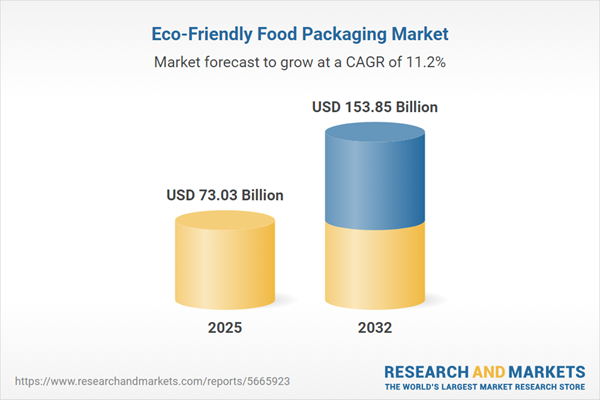Speak directly to the analyst to clarify any post sales queries you may have.
The Eco-Friendly Food Packaging Market is undergoing significant transformation, driven by mounting regulatory demands and a shift toward sustainability among modern consumers and industry leaders. Companies are reimagining solutions to reduce environmental impact while navigating complex supply chains and evolving industry benchmarks.
Market Snapshot: A Growing Eco-Friendly Food Packaging Sector
The eco-friendly food packaging market grew from USD 65.64 billion in 2024 to USD 73.03 billion in 2025. It is set to expand further at a CAGR of 11.23%, reaching USD 153.85 billion by 2032. This rapid growth is fuelled by global shifts in consumer attitudes, regulatory frameworks emphasizing sustainability, and advances in materials science, positioning eco-friendly packaging as a strategic imperative for brands across supply chains.
Scope & Segmentation: Comprehensive Market Coverage
This report provides a structured analysis across core market segments, product categories, end-use industries, and regional trends, presenting actionable intelligence for decision-makers.
- Material Types: Bagasse, Bio-Plastics (including Cellulose, PHA, PLA, Starch Blends), Cellulose-Based, Paper & Paperboard (Corrugated Board, Molded Pulp, Paperboard), Starch-Based
- Packaging Types: Flexible (Films & Wraps, Pouches), Rigid (Containers & Trays, Cups & Lids), Semi-Rigid
- Product Types: Containers & Trays, Cups & Lids, Films & Wraps, Pouches
- End Uses: E-Commerce, Food Service, Retail
- Technology Types: Compostable, Recyclable, Reusable
- Regional Coverage: Americas (North America: United States, Canada, Mexico; Latin America: Brazil, Argentina, Chile, Colombia, Peru), Europe, Middle East & Africa (Europe: United Kingdom, Germany, France, Russia, Italy, Spain, Netherlands, Sweden, Poland, Switzerland; Middle East: United Arab Emirates, Saudi Arabia, Qatar, Turkey, Israel; Africa: South Africa, Nigeria, Egypt, Kenya), Asia-Pacific (China, India, Japan, Australia, South Korea, Indonesia, Thailand, Malaysia, Singapore, Taiwan)
- Notable Companies: Amcor plc, Tetra Pak International S.A., Ball Corporation, WestRock Company, Smurfit Kappa Group plc, International Paper Company, Sealed Air Corporation, Berry Global, Inc., Huhtamaki Oyj, Mondi plc
Key Takeaways: Strategic Insights for Senior Decision-Makers
- Heightened regulatory attention and consumer awareness are accelerating innovation in compostable, recyclable, and reusable packaging solutions, shifting sustainability from a niche concern to a mainstream necessity.
- Packaging material selection is determined by factors such as product shelf-life, required barrier properties, and compatibility with waste management infrastructure, influencing operations from design through end-of-life.
- Flexible, rigid, and semi-rigid packaging formats each offer distinct benefits, supporting use cases spanning e-commerce, food service, and retail—enabling companies to target specific consumer and market needs.
- Regional adoption varies, with regions like Europe and North America favoring paperboard and extended producer responsibility programs, while Asia-Pacific regions emphasize lightweight solutions and rapid urbanization-driven applications.
- Industry leaders are building partnerships across supply chains and investing in advanced technologies such as smart labeling and digital traceability to validate sustainability claims and meet evolving compliance standards.
Tariff Impact: Navigating New Trade Realities in 2025
Recent United States tariff policies have introduced added costs for imported packaging components, prompting companies to increase local sourcing and diversify supply chains. This shift encourages greater reliance on domestically produced bagasse and starch materials and fuels investment in regional bioplastic manufacturing and logistics realignment. Adapting to these trade changes has fostered wider adoption of innovative packaging manufactured under favorable conditions, further linking economic policy with sustainability-driven strategy.
Methodology & Data Sources
The research utilizes a hybrid methodology combining in-depth primary interviews with industry stakeholders, expert validation, and robust secondary analysis. Scenario-based quantitative modeling enhances reliability, with input from academic advisors and cross-referencing of industry reports and regulatory documents to ensure actionable intelligence.
Why This Report Matters
- Enables leadership teams to prioritize investments and operational strategies aligned with sustainability, regulatory compliance, and market opportunity.
- Offers segment-specific insights vital for innovation, product development, and rapid adaptation to evolving material, format, and technology demands.
- Supports risk mitigation and opportunity capture through detailed regional and supply chain analysis tailored to senior executives seeking growth and resilience.
Conclusion
As the eco-friendly food packaging sector evolves, cross-industry collaboration and targeted innovation are central to meeting regulatory, consumer, and operational demands. This report equips senior decision-makers with the insights needed to lead sustainable transformation, optimize strategies, and drive measurable impact across the value chain.
Additional Product Information:
- Purchase of this report includes 1 year online access with quarterly updates.
- This report can be updated on request. Please contact our Customer Experience team using the Ask a Question widget on our website.
Table of Contents
3. Executive Summary
4. Market Overview
7. Cumulative Impact of Artificial Intelligence 2025
Companies Mentioned
The companies profiled in this Eco-Friendly Food Packaging market report include:- Amcor plc
- Tetra Pak International S.A.
- Ball Corporation
- WestRock Company
- Smurfit Kappa Group plc
- International Paper Company
- Sealed Air Corporation
- Berry Global, Inc.
- Huhtamaki Oyj
- Mondi plc
Table Information
| Report Attribute | Details |
|---|---|
| No. of Pages | 182 |
| Published | November 2025 |
| Forecast Period | 2025 - 2032 |
| Estimated Market Value ( USD | $ 73.03 Billion |
| Forecasted Market Value ( USD | $ 153.85 Billion |
| Compound Annual Growth Rate | 11.2% |
| Regions Covered | Global |
| No. of Companies Mentioned | 11 |









